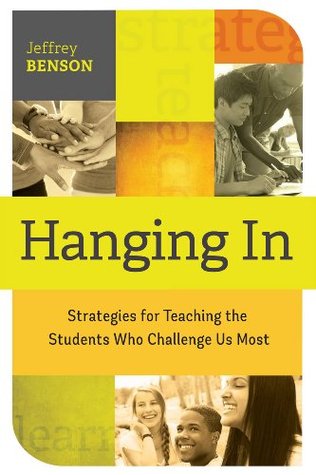More on this book
Kindle Notes & Highlights
Read between
August 24, 2017 - February 3, 2019
These students crisscross categories of disabilities, challenging us to develop new and complex interventions, in combinations we have never tried before.
a long list of potential problems: decreased concentration, fragmented memory,
poor organization, language deficits, perfectionism, depression, anxiety, and self-destructive behavior.
add to this list excessive absences, uneven skill development, and deficits in content knowledge. Now add a learning disability...
This highlight has been truncated due to consecutive passage length restrictions.
Dean brought up feelings of incompetence and despair. They were professional helpers, and Dean would not let them help; his failure became their failure.
students "can confirm or destroy" a teacher's "pride in craft."
"Because teachers' work consists of affecting their students, they are dependent on their students both for the actual success of their work and evidence of that success"
A challenging student provides one of the best means of reaching mastery in our field—but only when teachers themselves get support and safety, and when they are not dealing with many such students in isolation.
Our stories are valuable only inasmuch as we collectively construct their meaning and articulate a shared wisdom. Set time aside to tell stories. The learning must be made explicit; we hang in collectively.
To be fascinated with the thinking and growth of each student is a formula for lifelong learning as an educator.
however hard challenging students have been to teach, their lives have been exponentially more difficult to live.
As you read, if you are wondering how the lessons from each story apply to the students in your school, you are on the right path.
when we enter a school, we want to feel that we are in a special place, that we have stepped from the street into an environment that offers students opportunities that they don't experience elsewhere.
secured by the school having predictable rules and expectations, and the adults having predictable emotional responses to student activity.
Above all else, the foundation of schools that hang in with challenging students is building trusting relationships—relationships that allow these often overwhelmed young people to try again.
The Six Overarching Elements of Hanging In
exquisite respectfulness
apologize.
"Above all else, do not shame the student."
The sum total of a day in school should not be an overwhelming reminder of what students cannot do. Ensure that all students have a school adult or activity that connects them to their best possible selves.
We should be consistently checking in with challenging students about what they are seeing and understanding.
Consequences for mistakes (including punishments) should be time-limited and offer a realistic way to regain trust. As much as possible, and as soon as possible after the misstep, offer ways for students to demonstrate and practice the replacement skill.
Allowing multiple interests to inspire diverse solutions:
developing a rich menu of strategies.
Everyone who works primarily with challenging students should have an ally, a supportive supervisor, a coach.
At our school, no matter what Toni might say or do (in her case, academically more often not do), she was never shamed.
She tested everyone with her abrasive language, impatience, her dark moods, and her approach-and-avoidance behavior
identify which behaviors demand a rigidly consistent response and which behaviors suggest a more nuanced and context-specific response.
behaviors that are not to be tolerated, behaviors that the school can ignore, and behaviors we choose to respond to as teachable moments.
behaviors that are not to be tolerated,
behaviors that the school can ignore,
behaviors we choose to respond to as teachable moments.
Get Me Out of Trouble Plan
The shift for Toni's teachers was to see her as a sad and scared person, who had few tools at her disposal, ineffectively trying to get through her day. In her emotionally charged state, Toni did not yet have the cognitive capacity to modulate her behavior; the arousal process took her from stimulus to action in a short period of time (Siegel, 1999). She stomped away from teachers in shame from what she had just said and fear of what might next come out of her mouth.
"The only way to effectively manage provocative moments is for you, the classroom leader, to stay calm"
Toni's teachers, maintaining calm was supported by four important conditions: They knew what the absolutes were and what steps would be taken in those situations. They knew they had the latitude and flexibility to work with Toni in situations that were not absolute and that they would not be second-guessed. This assurance gave them the security to discuss how they might nudge Toni's learning even more the next time they were in a similar situation. They knew they could review as a team Toni's specific behavior plan, and its lists of absolute, ignored, and teaching moment behaviors, which
...more
Hanging-In Recommendations and Considerations for Individual Students
Create schedules that maximize students' contact with the adults who are having success building their trust.
Let staff who have established trust communicate to the student the school's expectations—what
Help each student develop simple coping tools for times of heightened emotions
Work with students to develop a signal for when they need to escape to a designated quiet place.
Don't enforce consequences immediately when de-escalating the situation with a student.
Build in time and positive feedback for students' individual accomplishments.
Don't stop giving sincere compliments when the student seems to be rejecting you—you
Hanging-In Recommendations and Considerations for the Adult Team
Storytelling:
Review all behaviors that require absolute and unvarying responses.
Develop specific behavior response plans for challenging students.
The professional culture of a school can erode when teachers feel compelled to go their own way in support of a needy student.
Figure 2.1 Voice Volume Poster


